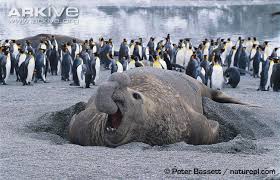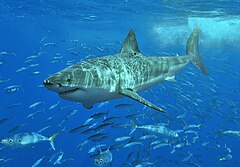Post by dinosauria101 on Apr 23, 2019 3:32:08 GMT 5
Southern Elephant Seal - Mirounga leonina
The Southern Elephant Seal (Mirounga leonina) is one of the two extant species of elephant seal. It is both the largest pinniped and member of the order Carnivora living today. The seal gets its name from its great size and the large proboscis of the adult males, which is used to make extraordinarily loud roaring noises, especially during the mating season. The Southern Elephant Seal is distinguished from the Northern Elephant Seal (which doesn't overlap in range with this species) by its greater body mass and a wider proboscis. This seals' size shows extreme sexual dimorphism, possibly the largest of any mammal, with the males typically five to six times heavier than the females. While the females average 400 to 900 kilograms (880 to 2,000 lb) and 2.6 to 3 meters (8.5 to 9.8 ft) long, the bulls average 2,200 to 4,000 kilograms (4,900 to 8,800 lb) and 4.5 to 5.8 meters (15 to 19 ft) long. The record-sized bull, shot in Possession Bay, South Georgia on February 28, 1913, measured 6.85 meters (22.5 ft) long and was estimated to weigh 5,000 kilograms (11,000 lb). The maximum size of a female is 1,000 kilograms (2,200 lb) and 3.7 meters (12 ft). When at the subantarctic or Antarctic coasts, the seals can also consume shellfish, nothothens, lanternfish, krill, cephalopods or even algae.

Great White Shark - Carcharodon carcharias
The great white shark, scientific name Carcharodon carcharias, also known as the great white, white pointer, white shark, or white death, is a large lamniform shark found in coastal surface waters in all major oceans. It is known for its size, with the largest individuals known to have approached or exceeded 6 metres (20 ft) in length, and 2,268 kilograms (5,000 lb) in weight. This shark reaches maturity at around 15 years of age and can have a life span of over 30 years. The great white shark is arguably the world's largest known extant macropredatory fish and is one of the primary predators of marine mammals. Great whites display countershading, having a white underside and a grey dorsal area (sometimes in a brown or blue shade) that gives an overall mottled appearance. Great white sharks, like many other sharks, have rows of serrated teeth behind the main ones, ready to replace any that break off. When the shark bites it shakes its head side to side, helping the teeth saw off large chunks of flesh. Males reach maturity at 3.5–4.0 metres (11–13 ft) and females at 4.5–5.0 m (15–16 ft). Adults on average are 4–5.2 m (13–17.1 ft) long and have a mass of 680–1,100 kilograms (1,500–2,400 lb). Females are generally larger than males. It is widely accepted that the great white shark can reach 6.1 m (20 ft) in length and 1,900 kg (4,200 lb) in weight. The maximum size is subject to debate because some reports are rough estimations or speculations performed under questionable circumstances. Great white sharks are carnivorous and prey upon fish (e.g. tuna, rays, other sharks), cetaceans (i.e., dolphins, porpoises, whales), pinnipeds (e.g. seals, fur seals, and sea lions), sea turtles, sea otters, and seabirds. Great whites have also been known to eat objects that they are unable to digest.

Credit to Wikipedia
The Southern Elephant Seal (Mirounga leonina) is one of the two extant species of elephant seal. It is both the largest pinniped and member of the order Carnivora living today. The seal gets its name from its great size and the large proboscis of the adult males, which is used to make extraordinarily loud roaring noises, especially during the mating season. The Southern Elephant Seal is distinguished from the Northern Elephant Seal (which doesn't overlap in range with this species) by its greater body mass and a wider proboscis. This seals' size shows extreme sexual dimorphism, possibly the largest of any mammal, with the males typically five to six times heavier than the females. While the females average 400 to 900 kilograms (880 to 2,000 lb) and 2.6 to 3 meters (8.5 to 9.8 ft) long, the bulls average 2,200 to 4,000 kilograms (4,900 to 8,800 lb) and 4.5 to 5.8 meters (15 to 19 ft) long. The record-sized bull, shot in Possession Bay, South Georgia on February 28, 1913, measured 6.85 meters (22.5 ft) long and was estimated to weigh 5,000 kilograms (11,000 lb). The maximum size of a female is 1,000 kilograms (2,200 lb) and 3.7 meters (12 ft). When at the subantarctic or Antarctic coasts, the seals can also consume shellfish, nothothens, lanternfish, krill, cephalopods or even algae.
Great White Shark - Carcharodon carcharias
The great white shark, scientific name Carcharodon carcharias, also known as the great white, white pointer, white shark, or white death, is a large lamniform shark found in coastal surface waters in all major oceans. It is known for its size, with the largest individuals known to have approached or exceeded 6 metres (20 ft) in length, and 2,268 kilograms (5,000 lb) in weight. This shark reaches maturity at around 15 years of age and can have a life span of over 30 years. The great white shark is arguably the world's largest known extant macropredatory fish and is one of the primary predators of marine mammals. Great whites display countershading, having a white underside and a grey dorsal area (sometimes in a brown or blue shade) that gives an overall mottled appearance. Great white sharks, like many other sharks, have rows of serrated teeth behind the main ones, ready to replace any that break off. When the shark bites it shakes its head side to side, helping the teeth saw off large chunks of flesh. Males reach maturity at 3.5–4.0 metres (11–13 ft) and females at 4.5–5.0 m (15–16 ft). Adults on average are 4–5.2 m (13–17.1 ft) long and have a mass of 680–1,100 kilograms (1,500–2,400 lb). Females are generally larger than males. It is widely accepted that the great white shark can reach 6.1 m (20 ft) in length and 1,900 kg (4,200 lb) in weight. The maximum size is subject to debate because some reports are rough estimations or speculations performed under questionable circumstances. Great white sharks are carnivorous and prey upon fish (e.g. tuna, rays, other sharks), cetaceans (i.e., dolphins, porpoises, whales), pinnipeds (e.g. seals, fur seals, and sea lions), sea turtles, sea otters, and seabirds. Great whites have also been known to eat objects that they are unable to digest.

Credit to Wikipedia







